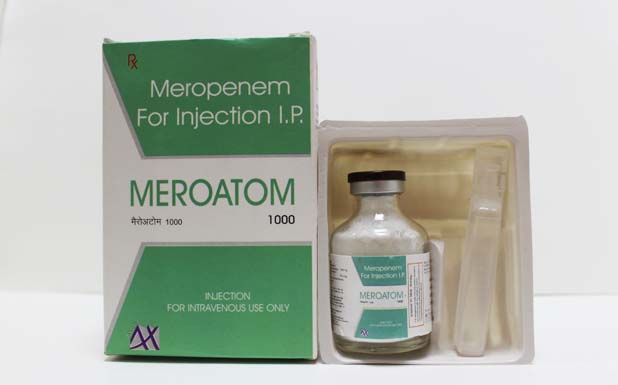
Composition
- Each vial Contains:
- Meropenem
1 gm
Packing
- WFI (1X15)
(With Carton)
MRP
- 1490
Overview
Meropenem is a broad-spectrum carbapenem antibiotic. It is active against Gram-positive and Gram-negative bacteria. It exerts its action by penetrating bacterial cells readily and interfering with the synthesis of vital cell wall components, which leads to cell death.
Indications
For use as single agent therapy for the treatment of the following infections when caused by susceptible isolates of the designated microorganisms: complicated skin and skin structure infections due to Staphylococcus aureus (b-lactamase and non-b-lactamase producing, methicillin-susceptible isolates only), Streptococcus pyogenes, Streptococcus agalactiae, viridans group streptococci, Enterococcus faecalis (excluding vancomycin-resistantisolates), Pseudomonas aeruginosa, Escherichia
coli, Proteus mirabilis
Also for use in the treatment of bacterial meningitis caused by Streptococcus pneumoniae, Haemophilus influenzae (b-lactamase and non-b-lactamase-producing isolates), and Neisseria meningitidis.
Pharmacology
Mechanism of action:
The bactericidal activity of meropenem results from the inhibition of cell wall synthesis. Meropenem readily penetrates the cell wall of most Gram-positive and Gram-negative bacteria to reach penicillin-binding- protein (PBP) targets. Its strongest affinities are toward PBPs 2, 3 and 4 of Escherichia coli and Pseudomonas aeruginosa; and PBPs 1, 2 and 4 of Staphylococcus aureus.Pharmacodynamics:
Meropenem is a broad-spectrum carbapenem antibiotic. It is active against Gram-positive and Gram-negative bacteria. Meropenem exerts its action by penetrating bacterial cells readily and interfering with the synthesis of vital cell wall components, which leads to cell death
Pharmacokinetics:
Absorption:
Meropenem is not absorbed after oral administration. It penetrates well into most body fluids and tissues, including CSF, achieving concentrations matching or exceeding those required to inhibit most susceptible bacteria.
Metabolism:
Primarily excreted unchanged. There is one metabolite which is microbiologically inactive
Distribution: The volume of distribution is 21L, indicating predominantly extracellular distribution. IT distributes partly into cerebrospinal fluid. The drug is eliminated both by metabolism and excretion. The t1/2 of meropenem is prolonged in patients with renal insufficiency and correlates well with creatinine clearance.
Elimination:
Approximately 70% of the intravenously administered dose is recovered as unchanged meropenem in the urine over 12 hours, after which little further urinary excretion is detectable.
Contraindications
Who should not take Meropenem Vial?diarrhea from an infection with Clostridium difficile bacteria.
decreased blood platelets.
lesion of the brain.
seizures.
kidney disease with likely reduction in kidney function.
Side Effects